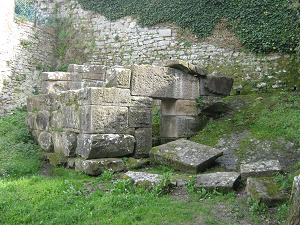Archaeological Museum conserves finds discovered in the city; it's possibile to visit the place where some of theese finds were discovered, walking around Fiesole.
Specially, we suggest etruscan walls, archaeological site "Area Garibaldi" and tombs in via del Bargellino.
Etruscan walls

Fiesole was built on top of a hill, as were the majority of Etruscan cities, probably during the IV century BC. Strong city walls were a valid defence against enemies until 1125, when Florence was successful in conquering Fiesole and ordered the partial destruction of the walls.
The surrounding walls were approximately 2.5 km long, reaching from the hill of San Francesco to the area known as Borgunto, very close to the stone caves of Montececeri, which provided part of the building materials for the wall.
Nowadays it is possible to observe the most awe-inspiring remains of the city walls on Via delle Mura Etrusche (literally: the road of the Etruscan walls), outside the Archaeological Area, and on Via Mari, on the eastern side of Fiesole. A large part of the ruins are no longer visible because they are located inside areas belonging to private gardens.
Few details are available about the ancient gateways to the city, with the exception of one threshold on the northern side, still unmistakable thanks to the remains of part of a parallel wall joined to the main structure by a perpendicular wall.
Le tombe di via del Bargellino

Following via Matteotti, in the direction of Borgunto (on the eastern side of Fiesole), tourists unexpectedly find two Etruscan tombs, overlooked by via del Bargellino and hidden among the modern buildings. These tombs dated back to the IV century BC were part of an Etruscan necropolis, that extended across the city walls.
These two chamber tombs have a quadrangular shape and dry stone walls.
Stone urns and wares are unearthed inside the two graves: the grave goods (small bronze objects and wares) are now displayed in the archaeological museum.
"Area Garibaldi" archaeological site

Longobards tombs inside the Archaeological Museum are from the excavation in the centre of Fiesole, behind the city hall (1986 - 2015).
Digging there, archaeologists found evidences from IV century BC until longobard period (VI - VIII century).
Nowadays are visible the ruins of the perystile of a roman house (domus), with part of colonnade and the central tank (I century BC - I century AD).
After some new settlements, during about the V century Longobards installed here a cemetery digging the tombs between roman ruins.
Some graves are still visible near the city hall.
The skeletons and the objects discovered inside them (now conserved in the Archaeological Museum) are very important to study history of Fiesole and Longobards age.
"Area Garibaldi" is free and accessible to everyone, thanks to paths and information plaques (in braille too).
